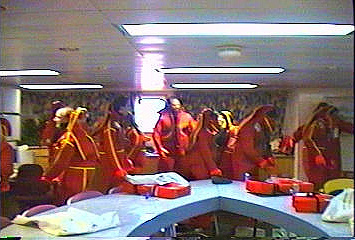16 April, 1999
Dear Friends:
At 9:30 this morning, the great engines within the bowels of the ship
roared and an odd sensation came
over me…the ship was moving. No warning, no whistles or bells, just the
appointed time and like
clockwork, we left, with UPS up and running! I think everyone breathed
easier knowing that on top of all
the other perils, the equipment would not have to be put at risk.
Considering the investment in both time
and money that people had spent developing these analytical devices, I’m
sure it was a tremendous load off
many people’s minds.
We had yet more preliminary meetings this morning, with lab safety being
stressed and then introductions
of the team members to each other, and questions and answers about the
itinerary (I’ll write more on this as
I learn more). In the midst of this, the emergency fire alarm sounded. We
looked at each other
momentarily and then realized…we had to get moving! Racing down the halls
to our cabins, we picked up
our survival gear as we had been told. Some thought enough to bring land
gear in case surviving carried
over to landfall. The ocean survival suits would be worthless on shore but
to sleep in. You could not move
about much in them. Their sheer function was to keep you afloat and warm
for hours, versus the certain
expiration within minutes of being immersed in waters that could hit –4
celsius. We assembled in the
muster room – a conference room on deck 3 next to the lifeboats, to find
that it was a drill. Not bad, but
next time, the safety officer said, we would have to halve the time…
After the drill, we continued our introductions and then moved below again
to the computer lab to learn
how to edit the ping data – sonar data that had erroneous data points at
the borders of each swath obtained.
Some how the multibeam sonar arrangement in this ship was sensitive to the
ship’s configuration and
resulted in stray data points, ghost peaks where none were expected. I’ll
try to send a sample picture, but
basically you displayed 10 – 20 traces from a contour map of the ocean
floor and looked for discontinuous
peaks, peaks that appeared at the edges without any continuous slope
leading up to them. By deleting
these, it is possible, with multiple swaths, to obtain a fairly accurate
ocean floor map. Everyone was
expected to put in a few hours a day editing. The significance was that we
were going where detailed maps
did not exist and would have to create our own in order to locate suspect
mounds/ridges for the sought after
vent sites.
As we moved on down the Magellan Straits, we had a westerly wind at our
backs, allowing us to reach 15
knots. Large swells would come rushing up from behind and overtake us,
causing breakers where our wake
and the swells confronted each other, but the swells ran deep and had built
for days…there was no contest.
The ocean makes it clear…she will win. The ship is large, powerful, solid.
You are dwarfed by her
machinery, her plates, bolts, the distances you can travel through her
halls and stairwells, yet she rocks,
lists, heaves as something far greater than she uncoils beneath her…and it
must be so, for her buoyancy is a
function of the mass of water she displaces…that which she displaces must
be greater for her to float. The
displacement is tentative at best, witnessed to by the rushing of the water
to fill the void behind, where we
were. Multiply this greatness by the millions and billions more volume in
the straits, bays or oceans within
sight and we see ourselves truly as a speck, no matter how large our
machinery.
I was excited to see a marine mammal that was colored like an Orca, yet
smaller, swimming beside the ship
for quite a distance. One of the marine scientists said that it was a
porpoise. It appeared to be playing in
our wake at 15 knots, racing along, then peeling off and dropping back,
just to repeat the process,
effortlessly (it appeared)!
Sunset was spectacular, making the land of fire live up to its name, Tierra
del Fuego. The name comes
from the fires that the Yahgan Indians built centuries ago to keep
themselves warm. Despite cold weather
year round, they wore little or no clothing, thus kept themselves warm by
building many fires, including in
their canoes!

We practice for an emergency abandoning of ship in our survival suits
Contact the TEA in the field at
.
If you cannot connect through your browser, copy the
TEA's e-mail address in the "To:" line of
your favorite e-mail package.
|
